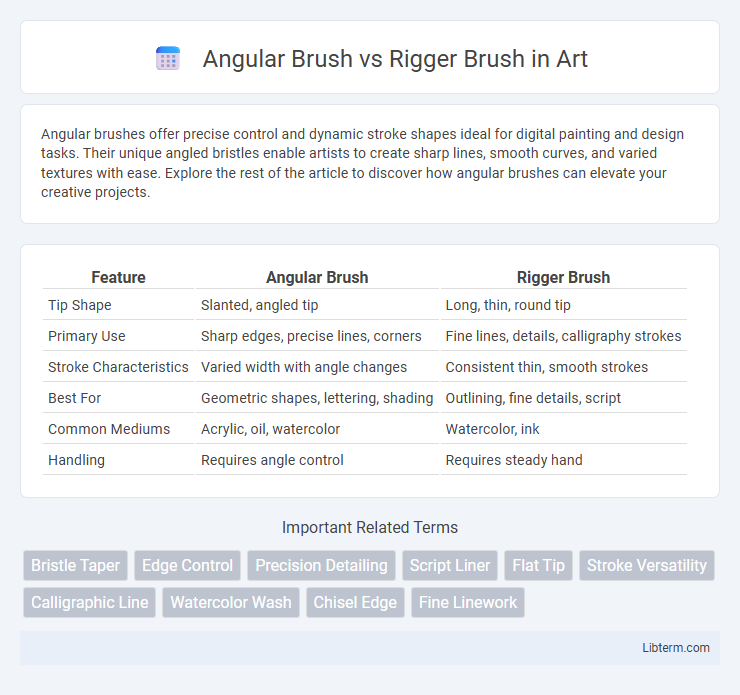Angular brushes offer precise control and dynamic stroke shapes ideal for digital painting and design tasks. Their unique angled bristles enable artists to create sharp lines, smooth curves, and varied textures with ease. Explore the rest of the article to discover how angular brushes can elevate your creative projects.
Table of Comparison
| Feature | Angular Brush | Rigger Brush |
|---|---|---|
| Tip Shape | Slanted, angled tip | Long, thin, round tip |
| Primary Use | Sharp edges, precise lines, corners | Fine lines, details, calligraphy strokes |
| Stroke Characteristics | Varied width with angle changes | Consistent thin, smooth strokes |
| Best For | Geometric shapes, lettering, shading | Outlining, fine details, script |
| Common Mediums | Acrylic, oil, watercolor | Watercolor, ink |
| Handling | Requires angle control | Requires steady hand |
Introduction to Angular and Rigger Brushes
Angular brushes feature bristles cut at an angle, enabling precision in creating sharp lines and curves, ideal for detailed painting and edging. Rigger brushes have long, thin bristles designed for fine lines and intricate details, commonly used in lettering and delicate work. Both brushes serve distinct purposes in art, with angular brushes excelling in controlled strokes and rigger brushes in extended, smooth lines.
Key Features of Angular Brushes
Angular brushes feature slanted bristles ideal for creating precise lines and sharp edges, making them perfect for detailed painting and cutting in corners. Their unique angled shape allows for excellent control and versatility when applying paint to complex surfaces or tight spots. These brushes excel in blending and shading techniques due to their ability to hold paint efficiently and release it smoothly.
Key Features of Rigger Brushes
Rigger brushes feature long, thin bristles designed for precise, continuous lines ideal for detailed work such as lettering, script, and fine strokes in painting. Their sturdy yet flexible construction allows for excellent control and consistent paint flow, making them suitable for intricate designs and calligraphy. The extended bristle length distinguishes them from angular brushes, which have short, slanted bristles used for sharp edges and bold strokes.
Applications of Angular Brushes
Angular brushes excel in reaching tight corners, edges, and detailed surfaces, making them ideal for painting window frames, door casings, and trim work. Their angled bristles offer precise control and smooth application on intricate areas where a rigger brush, designed primarily for fine lines and lettering, might prove less efficient. These brushes are widely used in both interior and exterior painting projects requiring sharp edges and clean lines, enhancing finish quality and reducing touch-ups.
Applications of Rigger Brushes
Rigger brushes, characterized by their long, thin bristles, excel in creating fine lines and detailed strokes ideal for painting rigging lines on ship models and intricate architectural elements. Their design suits applications requiring precision in oil, acrylic, and watercolor mediums, often used by artists for adding delicate highlights and complex linear textures. Unlike angular brushes that focus on bold edges and shape definition, rigger brushes provide control for meticulous detailing in miniature and fine art painting.
Comparing Brush Shapes and Sizes
Angular brushes feature a sharp, slanted edge ideal for precise lines and tight corners, while rigger brushes possess long, thin bristles designed for fine, continuous strokes such as script or detailed line work. Angular brushes vary in size from small (2mm) for detail work to large (25mm) for bold strokes, whereas rigger brushes typically come in smaller sizes, ranging from 0 to 6, to facilitate controlled, delicate painting. The choice between these brushes depends on the required brushstroke control and surface area coverage in painting projects.
Best Paint Types for Each Brush
Angular brushes excel with acrylic and oil paints, offering precise control and clean lines suitable for detailed work and sharp edges. Rigger brushes perform best with acrylic and watercolor paints due to their fine, long bristles, allowing for smooth, continuous lines and intricate detailing. Choosing the right brush and compatible paint type maximizes technique effectiveness and surface finish quality.
Precision and Versatility: Side-by-Side
Angular brushes provide superior precision with their sharply angled bristles, enabling detailed strokes and clean lines ideal for intricate work and tight corners. Rigger brushes feature long, thin bristles designed for fluid, continuous lines, offering unmatched versatility in creating fine details and dynamic strokes across various painting styles. Comparing both, angular brushes excel in controlled, precise applications, while rigger brushes deliver versatility through smooth, elongated brushstrokes suited for expressive detailing.
Choosing the Right Brush for Your Art Style
Choosing the right brush between an angular brush and a rigger brush depends on your art style and desired stroke precision. Angular brushes excel in creating sharp edges, bold strokes, and varied line widths, making them ideal for dynamic shapes and structured designs. Rigger brushes offer fine, consistent lines perfect for detailed work, delicate hairlines, and crisp outlining in intricate illustrations.
Care and Maintenance Tips for Both Brushes
Proper care and maintenance of Angular Brushes and Rigger Brushes involve thorough cleaning immediately after use to prevent paint buildup and bristle damage. For Angular Brushes, gently reshape the angled bristles and store them flat or upright to maintain their precise edge, while Rigger Brushes require careful cleaning of their long, thin bristles and storage in a protective tube or container to avoid bending or fraying. Using mild soap and lukewarm water for water-based paints or appropriate solvents for oil-based paints ensures durability and extends the lifespan of both brush types.
Angular Brush Infographic

 libterm.com
libterm.com